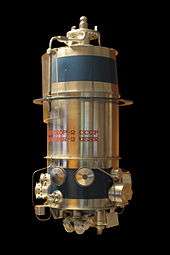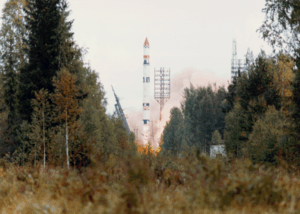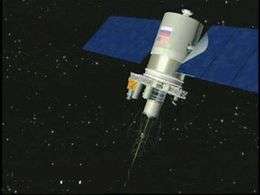Meteor (satellite)

The Meteor spacecraft are weather observation satellites launched by the USSR and Russia. The Meteor satellite series was developed during the 1960s.[1][2] The Meteor satellites were designed to monitor atmospheric and sea-surface temperatures, humidity, radiation, sea ice conditions, snow-cover, and clouds.
Satellites
Meteor-1
- Meteor-1 launches
| Satellite | Launch date | NSSDC ID | SCN | Apogee, km | Perigee, km | Inclination | Period, min | Note |
|---|---|---|---|---|---|---|---|---|
| Kosmos-44 | August 28, 1964 | 1964-053A | 00876 | 857 | 615 | 65.04° | Technology demonstrator | |
| Kosmos-58 | February 26, 1965 | 1965-014A | 01907 | 647 | 563 | 65° | Technology demonstrator | |
| Kosmos-100 | December 17, 1965 | 1965-106A | 01843 | 658 | 630 | 65° | Technology demonstrator | |
| Kosmos-118 | May 11, 1966 | 1966-038A | 02168 | 657 | 587 | 65° | Technology demonstrator | |
| Kosmos-122 | June 25, 1966 | 1966-057A | 02254 | 657 | 583 | 65.14° | Technology demonstrator | |
| Kosmos-144 | February 28, 1967 | 1967-018A | 02695 | 625 | 625 | 81.2° | 96.9 | |
| Kosmos-156 | April 27, 1967 | 1967-039A | 02762 | 630 | 630 | 81.2° | 97.0 | |
| Kosmos-184 | October 25, 1967 | 1967-102A | 03010 | 635 | 635 | 81.2° | 97.1 | |
| Kosmos-206 | March 14, 1968 | 1968-019A | 03150 | 630 | 630 | 81.2° | 97.0 | |
| Kosmos-226 | June 12, 1968 | 1968-049A | 03282 | 603 | 650 | 81.2° | 96.9 | |
| — | February 1, 1969 | — | — | — | — | — | — | Launch failure |
| Meteor-1 1 | March 26, 1969 | 1969-029A | 03835 | 644 | 713 | 81.2° | 97.9 | |
| Meteor-1 2 | October 6, 1969 | 1969-084A | 04119 | 630 | 690 | 81.2° | 97.7 | |
| Meteor-1 3 | March 17, 1970 | 1970-019A | 04349 | 555 | 643 | 81.2° | 96.4 | |
| Meteor-1 4 | April 28, 1970 | 1970-037A | 04393 | 637 | 736 | 81.2° | 98.1 | |
| Meteor-1 5 | June 23, 1970 | 1970-047A | 04419 | 863 | 906 | 81.2° | 102.0 | |
| Meteor-1 6 | October 15, 1970 | 1970-085A | 04583 | 633 | 674 | 81.2° | 97.5 | |
| Meteor-1 7 | January 20, 1971 | 1971-003A | 04849 | 630 | 767 | 81.2° | 97.6 | |
| Meteor-1 8 | April 17, 1971 | 1971-031A | 05142 | 620 | 646 | 81.2° | 97.2 | |
| Meteor-1 9 | July 16, 1971 | 1971-059A | 05327 | 618 | 650 | 81.2° | 97.3 | |
| Meteor-1 10 | December 29, 1971 | 1971-120A | 05731 | 880 | 905 | 81.2° | 102.7 | |
| Meteor-1 11 | March 30, 1972 | 1972-022A | 05917 | 878 | 903 | 81.2° | 102.6 | |
| Meteor-1 12 | June 30, 1972 | 1972-049A | 06079 | 897 | 929 | 81.2° | 103.0 | |
| Meteor-1 13 | October 27, 1972 | 1972-085A | 06256 | 893 | 904 | 81.2° | 102.6 | |
| Meteor-1 14 | March 20, 1973 | 1972-085A | 06392 | 882 | 903 | 81.2° | 102.6 | |
| Meteor-1 15 | May 29, 1973 | 1973-034A | 06659 | 867 | 909 | 81.2° | 102.5 | |
| Meteor-1 16 | March 5, 1974 | 1974-011A | 07209 | 853 | 906 | 81.2° | 102.2 | |
| Meteor-1 17 | April 24, 1974 | 1974-025A | 07274 | 877 | 907 | 81.2° | 102.6 | |
| Meteor-1 19 | October 28, 1974 | 1974-083A | 07490 | 855 | 917 | 81.2° | 102.5 | |
| Meteor-1 20 | December 17, 1974 | 1974-099A | 07574 | 861 | 910 | 81.2° | 102.4 | |
| Meteor-1 21 | April 1, 1975 | 1975-023A | 07714 | 877 | 906 | 81.2° | 102.6 | |
| Meteor-1 22 | September 18, 1975 | 1975-087A | 08293 | 867 | 918 | 81.2° | 102.3 | |
| Meteor-1 23 | December 25, 1975 | 1975-124A | 08519 | 857 | 913 | 81.2° | 102.4 | |
| Meteor-1 24 | April 7, 1976 | 1976-032A | 08799 | 863 | 906 | 81.2° | 102.3 | |
| Meteor-1 26 | October 16, 1976 | 1976-102A | 09481 | 871 | 904 | 81.3° | 102.5 | |
| Meteor-1 27 | April 5, 1977 | 1977-024A | 09903 | 869 | 909 | 81.3° | 102.5 | |
| References: [3][4][5] | ||||||||
Meteor-2
Meteor-2-21
Meteor-2-21/Fizeau is the twenty-first and last in the Meteor-2 series of Russian meteorological satellites, which were launched 22 times from 1975 to 1993.[6]
ILRS Mission Support Status: Satellite Laser Ranging (SLR) tracking support of this satellite was discontinued in October 1998. What makes Meteor-2-21 distinctive from the other meteorological satellites is its unique retroreflector array. Fizeau is named after a French physicist, Armand Fizeau, who in 1851 conducted an experiment which tested for the aether convection coefficient. SLR tracking of this satellite was used for precise orbit determination and the Fizeau experiment. The Fizeau experiment tests the theory of special relativity – that distance events that are simultaneous for one observer will not be simultaneous for an observer in motion relative to the first.
RetroReflector Array (RRA) Characteristics: The retro-reflector array consists of three corner cubes in a linear array with the two outer corner cubes pointing at 45 degree angles relative to the central cube. The central cube is made of fused silica and has a two-lobe Far Field Diffraction Pattern (FFDP) providing nearly equal intensities for compensated and uncompensated velocity aberration. Both outer reflectors have aluminum coating on the reflecting surfaces and near-diffraction-limited FFDPs. One of the end reflectors is made of fused silica with an index of refraction of 1.46 and should provide partial compensation of the velocity aberration. The other end reflector is made of fused glass with an index of refraction of 1.62 and should provide a perfect compensation of the velocity aberration.
SLR full-rate data from MOBLAS 4, MOBLAS 7, and Maidanak seem to confirm the presence of the compensating influence of the Fizeau effect. Resur-1, another Russian satellite launched in 1994, has 2 corner cubes reflectors with near diffraction-limited FFDPs, which were specifically designed for the continuation of this experiment. WESTPAC, a future SLR satellite, will verify indisputably the existence or otherwise of the Fizeau effect.
Instrumentation: Meteor-2-21/Fizeau had the following instrumentation on board:
- Scanning telephotometer
- Scanning infrared radiometers
- Radiation measurement complex
- Retroreflector array
Meteor-Priroda
- Meteor-Priroda launches
| Satellite | Launch date | NSSDC ID | SCN | Apogee, km | Perigee, km | Inclination | Period, min | Note |
|---|---|---|---|---|---|---|---|---|
| Use of Meteor-1 series platform | ||||||||
| Meteor-Priroda 1 (Meteor-1 18) | July 9, 1974 | 1974-052A | 07363 | 877 | 905 | 81.2° | 102.6 | |
| Meteor-Priroda 2-1 (Meteor-1 25) | May 15, 1976 | 1976-043A | 08845 | 866 | 900 | 81.2° | 102.4 | |
| Use of Meteor-2 series platform | ||||||||
| Meteor-Priroda 2-2 (Meteor-1 28) | June 29, 1977 | 1977-057A | 10113 | 602 | 685 | 98.0° | 97.5 | |
| Meteor-Priroda 2-3 (Meteor-1 29) | January 25, 1979 | 1979-005A | 11251 | 628 | 657 | 97.9° | 97.4 | |
| Meteor-Priroda 3-1 (Meteor-1 30) | June 18, 1980 | 1980-051A | 11848 | 589 | 678 | 97.9° | 97.3 | |
| Meteor-Priroda 2-4 (Meteor-1 31) | July 10, 1981 | 1981-065A | 12585 | 611 | 688 | 97.9° | 97.6 | |
| References: [7][4][5] | ||||||||
Meteor-3

The Meteor-3 series was launched 7 times between 1984 and 1994 after a difficult and protracted development program that began in 1972. All the satellites were launched on Tsyklon-3 rockets.[8] These satellites provide weather information including data on clouds, ice and snow cover, atmospheric radiation and humidity. The Meteor-3 class of satellites orbit in a higher altitude than the Meteor-2 class of satellites thus providing more complete coverage of the Earth's surface. The Meteor-3 has the same payload as the Meteor-2 but also includes an advanced scanning radiometer with better spectral and spatial resolution and a spectrometer for determining total ozone content. Meteorological data is transmitted to four primary sites in the former Soviet Union in conjunction with about 80 other smaller sites.
- Meteor-3 launches
| Satellite | s/n | Launch date | NSSDC ID | SCN | Apogee, km | Perigee, km | Inclination | Period, min | Note |
|---|---|---|---|---|---|---|---|---|---|
| Kosmos 1612 | 1 | November 27, 1984 | 1984-120A | 15406 | 130.2 | 1230.8 | 82.61° | 98.15 | launch failure, stage 3 failed to reignite |
| Meteor-3 1 | 2 | October 24, 1985 | 1985-100A | 16191 | 1236.0 | 1264.0 | 82.53° | 110.32 | |
| Meteor-3 2 | 3 | July 26, 1988 | 1988-064A | 19336 | 1198.2 | 1221.9 | 82.55° | 109.42 | |
| Meteor-3 3 | 4 | October 25, 1989 | 1989-086A | 20305 | 1191.0 | 1228.0 | 82.57° | 109.49 | |
| Meteor-3 4 | 6 | April 24, 1991 | 1991-030A | 21232 | 1190.0 | 1229.0 | 82.55° | 109.50 | |
| Meteor-3 5 | 5 | August 15, 1991 | 1991-056A | 21655 | 1199.7 | 1220.1 | 82.57° | 109.40 | |
| Meteor-3 6 | 7 | January 25, 1994 | 1994-003A | 22969 | 1191 | 1228 | 82° | 109.40 | |
| References: [9][10][8] | |||||||||
Meteor-3-5
Meteor-3-5, launched in 1991, is in a slightly higher orbit than Meteor-2-21, and operated until 1994. It transmitted on 137.300 MHz. Mechanically, it is similar to Meteor-2-21. Which satellite was in operation depended on the sun angles and consequently the seasons. Meteor-3-5 was usually the (Northern Hemisphere) "summer" satellite while 2-21 was in operation for approximately the half-year centered on winter. The satellite carried the second Total Ozone Mapping Spectrometer (TOMS) aloft as the first and the last American-built instrument to fly on a Soviet spacecraft. Launched from the Plesetsk, Russia, facility near the White Sea, on 15 August 1991, Meteor-3 TOMS had a unique orbit that presents special problems for processing data. Meteor-3 TOMS began returning data in August 1991 and stopped in December 1994.
Meteor-3-6/PRARE
The Meteor-3-6/PRARE satellite is the sixth in the Russian Meteor-3 series of meteorological satellites launched in 1994.
ILRS Mission Support Status: Satellite laser ranging and PRARE data was used for precision orbit determination and intercomparison of the two techniques. ILRS tracking support of this satellite was discontinued on 11 November 1995.
Instrumentation: Meteor-3-6 has the following instrumentation on board:
- Scanning TV-sensor
- Visible light and infrared radiometers
- Scanning infrared radiometer
- Ozone Mapper
- Precise Range and Range-Rate Equipment (PRARE)
- Retroreflector array
RetroReflector Array (RRA) Characteristics: The retro-reflector array is a box wing annulus with a diameter of 28 cm and has 24 corner cube reflectors.
Meteor-3M

The Meteor-3M series of satellites was to be an advanced series of polar orbiters with one 1.4 km resolution visible channel and a ten-channel radiometer with 3 km resolution. Initially four Meteor-3M satellites were planned, however due to financial difficulties only one was launched.[11]
Meteor-M
See also
- Elektro–L, Russian geosynchronous meteorological satellites
References
- ↑ Soviet Weather Satellite Falls in Antarctica, RIA Novosti, 27 March 2012, accessed 28 March 2012
- ↑ Soviet Weather Satellite Falls in Antarctica, RIA Novosti on SpaceDaily.com, 28 March 2012
- ↑ "Meteor-1". space.skyrocket.de. Retrieved 2016-04-04.
- 1 2 "Meteor - eoPortal Directory - Satellite Missions". directory.eoportal.org. Retrieved 2016-04-05.
- 1 2 "П. А. Румянцев. Космическая система Метеор". epizodsspace.airbase.ru. Retrieved 2016-04-04.
- ↑ Meteor-2, Encyclopedia Astronautica, accessed 17 September 2013
- ↑ "Meteor-Priroda". space.skyrocket.de. Retrieved 2016-04-05.
- 1 2 "Meteor-3". www.astronautix.com. Retrieved 2016-04-19.
- ↑ "Meteor-3 (17F45)". space.skyrocket.de. Retrieved 2016-04-19.
- ↑ "Космодром "Плесецк" | Информационный бюллетень №27". www.plesetzk.ru. Retrieved 2016-04-19.
- ↑ "Meteor satellite". www.russianspaceweb.com. Retrieved 2016-04-03.
